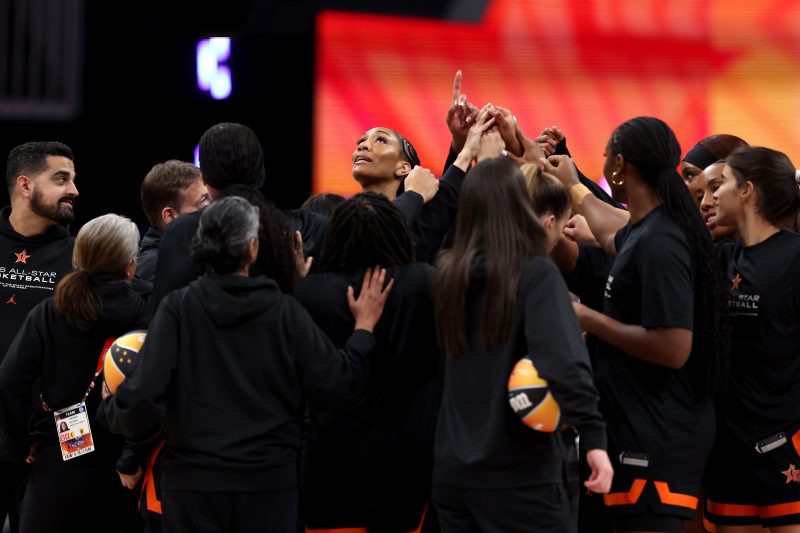INDIANAPOLIS — Some friendly advice for WNBA leaders as they negotiate with the players on a new contract:
Don’t make the same mistake U.S. Soccer did in 2019 by underestimating the players’ resolve. It will not go well for you, either in the negotiations or the court of public opinion.
The players and the WNBA had their first face-to-face meeting in months Thursday during All-Star weekend. To say it was lacking in substance is an understatement. “Wasted opportunity,” “disrespectful’ and ‘frustration’ were words used by players to describe it.
It did serve one purpose, however. With 40 players showing up — veterans and rookies, megastars and role players, the largest gathering outside the Wubble — it sent an unmistakable message to the league about their commitment.
“I hope it expedites the process so we’re not going back and forth where they’re trying to test us and see who flinches first. Because we’re not going to,” Minnesota Lynx forward Napheesa Collier, a WNBPA vice president as well as this season’s favorite for MVP, said Friday.
“We are always going to stand firm. Hopefully they just realize that earlier, so that we’re not wasting time over things that we’re not moving on.”
The W, like U.S. Soccer, seems to think players should be grateful just to be playing. That the money the NBA and some of its owners pumped into the league entitles them to gouge the players in perpetuity.
Funny how this is never an issue with men’s teams, even the ones that are perennial money losers.
The W didn’t respond to the players Friday. But on Thursday night, league commissioner Cathy Engelbert told The Associated Press the talks are “a process.”
“We’re both in listening mode,” Engelbert told the AP. “We’re going back and forth on issues. We know what’s important to players. We know what’s important to owners and striking the right balance.”
Does the W really, though? Because it’s been nine months since the players opted out of the existing contract and five months since the players sent the league ideas for salary increases and pay structure. To show up Thursday unprepared or unwilling to negotiate is not the move of a league that understands the urgency and gravity of the moment.
“It was pretty shocking to see,” New York Liberty forward Breanna Stewart, also a union vice president, said. “Not many things did we both agree on. I think there were two bullet points where we were like, `OK, we can move forward with this.’”
But this is what happens when women aren’t taken seriously.
When the U.S. women’s national team sued U.S. Soccer for equal pay in 2019, three months before the World Cup, the federation failed to appreciate how determined the players were. This despite the fact the players had taken the drastic step of suing their employer, and every single member of the team had signed onto the lawsuit.
The federation assumed, wrongly, that the women would eventually give in, preferring to get something rather than holding out for everything they deserved. They didn’t realize how knowledgeable the players and their advisers were about the economics.
U.S. Soccer’s biggest miscalculation, however, was not recognizing the public support for the players. When fans serenaded the USWNT with chants of “Equal pay! Equal pay!” after they won the World Cup in France, it was a resounding rebuke to U.S. Soccer and everyone else who short-changed women.
Sound familiar?
This is a time of explosive growth for the WNBA. A monster media rights deal that will pay the league $200 million a year, more than triple what it gets now, begins next year. Franchise valuations are soaring, with the expansion Golden State Valkyries recently valued at $500 million and five other teams worth $250 million or more, according to Sportico. Sponsors are clamoring for any piece of the action they can get.
None of this is a secret. Nor is it a secret that W players are woefully undercompensated. Player salaries top out at $250,000 and revenue “sharing” is around 10%, compared to the 50% that is typical of almost every professional men’s league.
The players, rightfully, want more. They know they deserve more. And, like the USWNT in 2019, they’re no longer willing to accept less.
“We’re not just players that run up and down the court and do amazing things. Some of us are business owners, some of us are foundation owners. So we know what it takes,” said Las Vegas Aces center A’ja Wilson, who, coincidentally, was wearing the latest version of her signature shoe released for the All-Star Game.
“When we see the revenue, when we see things flowing into our league, we want that. We are going to demand that because we see it and we see the growth,” Wilson said. “And when you see a business growing, obviously the people that are working for the business should have some say in that as well. So I think we know what we are talking about for sure.”
The public knows, too. Aside from the Neanderthals who parrot that misleading narrative of the W being propped up by the NBA, fans are going to be on the side of Caitlin Clark, Paige Bueckers, Wilson and Collier rather than rich owners and league officials.
So, too, will the sponsors. And when that happens, the league might regret its choices.
“We as players know what we’re worth. The fans know what we’re worth,” said Nneka Ogwumike, the longtime union president. “Now we need the league to know what we’re worth.’
The WNBA and its players will eventually come to an agreement. The league has a choice: Be seen as an equal partner that wanted to do right by the players or as an overlord that had to be dragged kicking and screaming into doing the right thing.
It might want to ask U.S. Soccer which one is better.
Follow USA TODAY Sports columnist Nancy Armour on social media @nrarmour.

